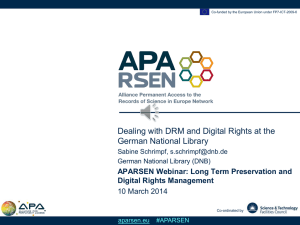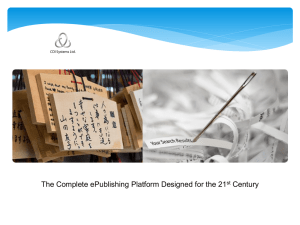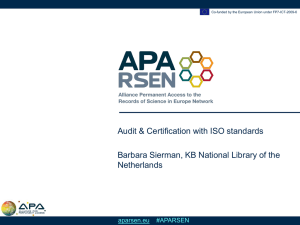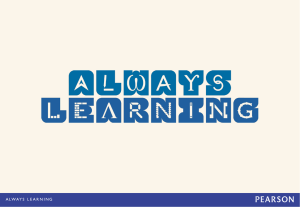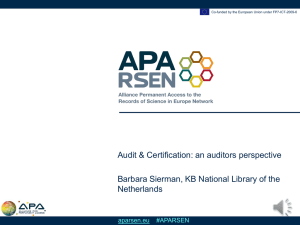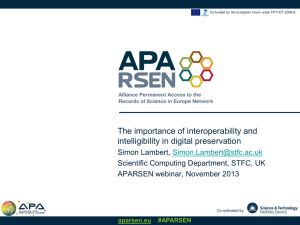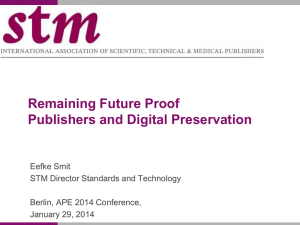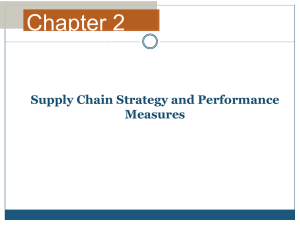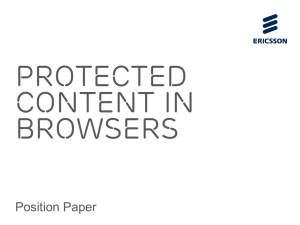APARSEN_DRM-webinar
advertisement
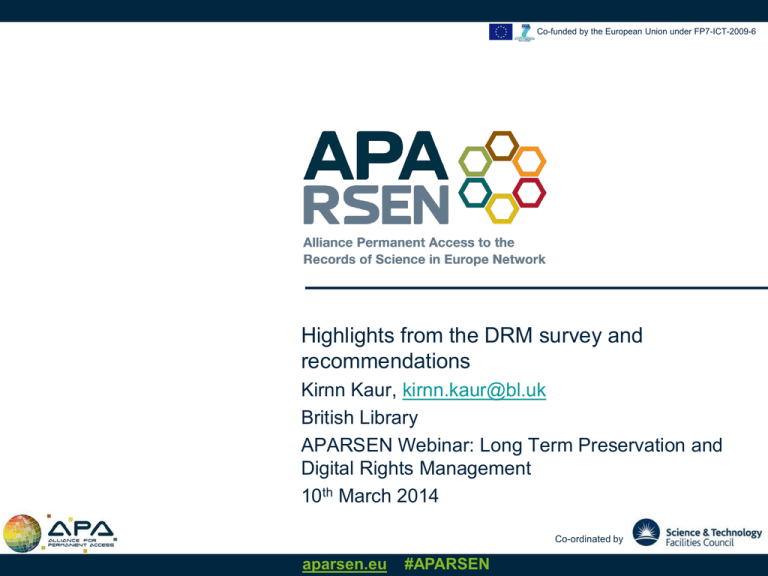
Co-funded by the European Union under FP7-ICT-2009-6 Highlights from the DRM survey and recommendations Kirnn Kaur, kirnn.kaur@bl.uk British Library APARSEN Webinar: Long Term Preservation and Digital Rights Management 10th March 2014 Co-ordinated by aparsen.eu #APARSEN Co-funded by the European Union under FP7-ICT-2009-6 Introduction • • • • • • Purpose of the survey Approach undertaken Respondents to the survey Survey highlights Recommendations Further information Highlights from the DRM survey and recommendations K Kaur, The British Library APARSEN Webinar: Long Term Preservation and DRM, 10th March 2014 aparsen.eu #APARSEN Co-funded by the European Union under FP7-ICT-2009-6 Purpose • The purpose of the survey was to find out how the participants handle: - DRM-protected material the associated rights • The primary aim was to discover how archiving of such objects is dealt with and what is being done to protect the rights information Highlights from the DRM survey and recommendations K Kaur, The British Library APARSEN Webinar: Long Term Preservation and DRM, 10th March 2014 aparsen.eu #APARSEN Co-funded by the European Union under FP7-ICT-2009-6 Approach • The approach was to focus on memory institutions as well • • • as research facilities and data centres To obtain new ideas on the approaches to handling DRM Web-based survey Carried out over Sept and Oct 2013 Highlights from the DRM survey and recommendations K Kaur, The British Library APARSEN Webinar: Long Term Preservation and DRM, 10th March 2014 aparsen.eu #APARSEN Co-funded by the European Union under FP7-ICT-2009-6 Survey respondents • 18 respondents, responses asked to be treated confidentially • except for four organisations Participants: - national libraries (n=9) scientific research organisations (n=3) archives (n=2) universities (n=2) one publisher one project • Geographically, 16 of the respondents were from Europe (Austria, Denmark, Finland, France, Germany, Italy, Netherlands, Switzerland and UK) with two were from the USA • .. Highlights from the DRM survey and recommendations K Kaur, The British Library APARSEN Webinar: Long Term Preservation and DRM, 10th March 2014 aparsen.eu #APARSEN Co-funded by the European Union under FP7-ICT-2009-6 Survey overview • Survey was divided into following sections: - Legislative framework The data stock Approach of dealing with DRM protected material Approach of dealing with digital rights Digital rights and access Dealing with DRM protected material as data holders Dealing with DRM protected material as data creators Highlights from the DRM survey and recommendations K Kaur, The British Library APARSEN Webinar: Long Term Preservation and DRM, 10th March 2014 aparsen.eu #APARSEN Co-funded by the European Union under FP7-ICT-2009-6 Survey highlights – legislative framework • Legal deposit legislation in various countries determines the format and delivery of digital publications • Organisations apply rights in accordance with copyright law • In the case of publishers, copyright law is applied based on authors' rights and contracts are in place to deal with rights issues • In other cases, there are limited legislative requirements in place • Where data is produced which may not be subject to legal controls such as copyright, due to the growing interest in the availability and re-use of this data access issues need to be considered Highlights from the DRM survey and recommendations K Kaur, The British Library APARSEN Webinar: Long Term Preservation and DRM, 10th March 2014 aparsen.eu #APARSEN Co-funded by the European Union under FP7-ICT-2009-6 Survey highlights – the data stock • The preservation of digital material varies depending on the organisation - Some have dealt with digital materials since their inception, others have inherited, or have grown as the amount of digital material being produced increases Where material has been held is historic or has been inherited, preservation may not have been undertaken • Data that has been archived varies enormously (publications, • research datasets, website archives, audio etc.), wide range of file formats Of the 18 respondents, 61% have dealt with DRM protected material, whilst 39% do not consider DRM to be an issue for their organisation Highlights from the DRM survey and recommendations K Kaur, The British Library APARSEN Webinar: Long Term Preservation and DRM, 10th March 2014 aparsen.eu #APARSEN Survey highlights: Co-funded by the European Union under FP7-ICT-2009-6 Approaches of dealing with DRM protected material 1 of 2 open access DRM provider allows access under specific usage scenarios using deposit licences in combination with conditions of use requiring potential data users to justify their use closed during an embargo period data creators asked to provide material free of DRM • Recommendation: data related to DRM should be collected automatically during business processes along the lifecycle of the digital object Highlights from the DRM survey and recommendations K Kaur, The British Library APARSEN Webinar: Long Term Preservation and DRM, 10th March 2014 aparsen.eu #APARSEN Survey highlights: Co-funded by the European Union under FP7-ICT-2009-6 Approaches of dealing with DRM protected material 2 of 2 Of the ten respondents more than half (60%) stated that they had no plans for a DRM mechanism for existing digital objects, however 40% stated plans were in place Highlights from the DRM survey and recommendations K Kaur, The British Library APARSEN Webinar: Long Term Preservation and DRM, 10th March 2014 aparsen.eu #APARSEN Survey highlights: Co-funded by the European Union under FP7-ICT-2009-6 Approach of dealing with digital rights (n=13) 62% stated that they processed and preserved rights information at object level 53% stated that metadata standards, like PREMIS and METSrights were in place Highlights from the DRM survey and recommendations K Kaur, The British Library APARSEN Webinar: Long Term Preservation and DRM, 10th March 2014 aparsen.eu #APARSEN Co-funded by the European Union under FP7-ICT-2009-6 Survey highlights: Digital rights and access • Software tools used for access (from most popular) - Developed in-house Commercial Open source • Access categories: - Access is limited Open access (as well as remotely) No public access • Where access is allowed this is mainly remotely with user authentication, in some cases access only in-house Highlights from the DRM survey and recommendations K Kaur, The British Library APARSEN Webinar: Long Term Preservation and DRM, 10th March 2014 aparsen.eu #APARSEN Co-funded by the European Union under FP7-ICT-2009-6 Survey highlights – approach of dealing with DRM protected material as data holders • 79% of the organisations (n=18) are data holders • 60% of respondents (n=10) stated that the detection of DRM and digital rights information is a part of their ingest process • Rights information may be included within deposit agreements • Automatic detection of DRM and digital rights can be undertaken using open-source tools • 60% of respondents (n=10) do not accept DRM protected material • Although some material cannot be provided without DRM, other material is ingested in bulk with no means of assessing the DRM status (i.e. bulk web harvesting) Highlights from the DRM survey and recommendations K Kaur, The British Library APARSEN Webinar: Long Term Preservation and DRM, 10th March 2014 aparsen.eu #APARSEN Co-funded by the European Union under FP7-ICT-2009-6 Survey highlights - approach of dealing with DRM protected material as data creators • Where data creators are also data holders, the same DRM • mechanism would apply to the material held as well as created Examples of approaches include: - - simple embargo where data is released after a defined timescale rights metadata is used to allow access via applicable services which apply relevant DRM. A publishing tool is used that automatically acts on the metadata and streaming allows viewing only but not downloading access to web pages are also designed using the underlying rights metadata controls are at item level which involves human interaction in order to determine the requirements for certain items and allows for the relevant actions as required Highlights from the DRM survey and recommendations K Kaur, The British Library APARSEN Webinar: Long Term Preservation and DRM, 10th March 2014 aparsen.eu #APARSEN Co-funded by the European Union under FP7-ICT-2009-6 Recommendations – general • Recommendations will facilitate the long term preservation of DRM protected materials and the protection of associated rights Keep the technical design simple Less variations make rights, process and roles more manageable and affordable Use standard tools Usage of standard tools for a specific format is more robust against error and has only impact on the specific file format DRM and Rights Policy Transparency in dealing with DRM and digital rights Collaboration archives between rights holders and Make the content creators and publishers aware of the risk that DRM carries related to long-term preservation so that they are more inclined to deposit digital objects free of DRM Highlights from the DRM survey and recommendations K Kaur, The British Library APARSEN Webinar: Long Term Preservation and DRM, 10th March 2014 aparsen.eu #APARSEN Co-funded by the European Union under FP7-ICT-2009-6 Recommendations on the handling of DRM protected materials DRM detection Is an object protected with DRM measures? Precondition for further measures. Format Policy The specification of preferred file formats facilitates the handling of utilized tools. Measures when DRM is detected Adequate measures like further examinations, request of DRM free versions of rejection, dependent of the employed DRM mechanism Documentation and Archiving of DRM Archiving of DRM protected objects and documentation of utilized measures in Data Management. The purpose is to facilitate activities that are targeted towards DRM protection measures like normalization into a DRM free format or copying onto a generic data carrier. DRM Removal If the legal conditions allow for it, the removal of DRM protection measures in order to derive an object without DRM. Analysing the existing data stock Detect potential risks related to DRM in time. The longer the risk remains undetected, the greater the risk that the content is lost. Highlights from the DRM survey and recommendations K Kaur, The British Library APARSEN Webinar: Long Term Preservation and DRM, 10th March 2014 aparsen.eu #APARSEN Co-funded by the European Union under FP7-ICT-2009-6 Recommendations on the protection of digital rights Detection of Rights Which rights are associated with the archival content? Are the rights information supplied by the content provider or do they have to be determined? Documentation and Application of Rights The structured storage, management and preservation of rights information in a Rights Management System that is connected to the access function. Access and use are managed in accordance with the rights information in the Rights Management System. Information about digital Rights Raise awareness of the user about the handling of digital materials. Storage in the Archival Package The additional storage of rights information with help of metadata standards like REL in the Archival Package. It allows the re-creation of rights information in case the Data Management or another Rights Management Systems is damaged or destroyed. Highlights from the DRM survey and recommendations K Kaur, The British Library APARSEN Webinar: Long Term Preservation and DRM, 10th March 2014 aparsen.eu #APARSEN Co-funded by the European Union under FP7-ICT-2009-6 Further information • Project website - www.aparsen.eu • Report - D31.1 Report on DRM preservation • Virtual Centre of Excellence - training material Highlights from the DRM survey and recommendations K Kaur, The British Library APARSEN Webinar: Long Term Preservation and DRM, 10th March 2014 aparsen.eu #APARSEN aparsen.eu Network of Excellence #APARSEN
